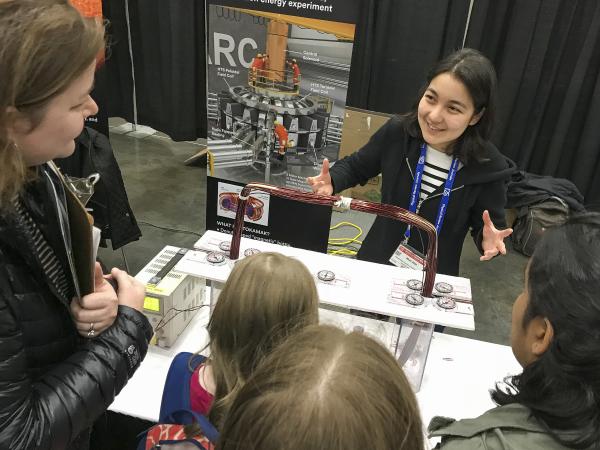
At the APS-DPP Plasma Science Expo MIT graduate student Muni Zhou demonstrates how to determine the direction of magnetic fields surrounding an electromagnet.
Paul Rivenberg
Portland meeting provides strong base for outreach to research colleagues and local community
November 20, 2018
When researchers, students and staff from MIT’s Plasma Science and Fusion Center (PSFC) made their annual trek to the American Physical Society Division of Plasma Physics (APS-DPP) meeting in November, they arrived in Portland, Oregon with multiple outreach goals. As in past years they helped educate the local community about plasma research and the benefits of fusion power. This year they also provided their colleagues opportunities to learn about SPARC, the new kid on the fusion community block since the last APS-DPP meeting.
The PSFC introduced SPARC for the first time at a scientific conference on November 6, as part of APS-DPP technical sessions devoted to MIT’s high-field approach to fusion. The project, which has received funding from Commonwealth Fusion Systems (CFS), proposes a faster, more economical path to fusion using a new high-temperature-superconducting (HTS) magnet technology. The three-hour series of morning talks also presented recent research based on data from MIT’s Alcator C-Mod tokamak, no longer in operation, and several PSFC tokamak collaborations, including DIII-D and ASDEX Upgrade.
That afternoon, the PSFC arranged an informal gathering to provide information about SPARC. Moderated by PSFC director Dennis Whyte, deputy director Martin Greenwald and CFS CEO Robert Mumgaard, the session explained the project’s organization, including its relationship to MIT, CFS and its investors. Those attending had an opportunity to ask questions on some of the less technical aspects of SPARC and learn about the potential for broad collaboration. A SPARC information table, available throughout the meeting, provided an opportunity to learn more, and to sign up for future communications.
Concurrent with these efforts to reach fellow scientists was an equally energetic push to reach Portland students, teachers and the general public. PSFC Outreach coordinator, Paul Rivenberg, worked throughout the year with the APS-DPP Education Committee to arrange opportunities for the local community.
APS-DPP introduced themselves to Portland on November 5 with a Science on Tap evening at the Alberta Rose Theatre entitled, “Fusion: Creating a Star on Earth for Clean and Limitless Energy.” Featuring APS-DPP Education Chair and MIT alumnus Arturo Dominguez, and plasma physicist Tammy Ma, from Lawrence Livermore’s National Ignition Facility, the program used laser pointers, diffraction gratings, glow discharge tubes and even helium balloons to entertain and educate. The theater audience of 200 sipped local brews and savored home-made vegetarian hand pies while learning how researchers are trying to harness the power of the sun to create a clean, reliable, limitless source of energy to meet the energy demands of the future.
“The Science on Tap is new for APS-DPP,” noted Dominguez, who is Science Education Senior Program Leader at Princeton Plasma Physics Laboratory. “But it was so successful we plan to find a way to integrate it into future meetings.”
Teachers were the target audience on November 6, when APS-DPP provided a day of workshops about plasma, fusion and related sciences free of charge, even providing funds for substitutes to cover participants’ classes. PSFC researcher Ted Golfinopoulos provided a “Fusion 101” overview for middle school teachers, while postdoctoral associate Andrew Seltzman explored how to bring plasma into a science curriculum with inexpensive hands-on demonstrations. Thirty-two teachers took advantage of the chance to engage with plasma physicists, leaving with bags full of plasma demonstration equipment.
Education activities focused on local middle and high school students during the final two days of the conference, when the Plasma Science Expo took over Hall B of the Oregon Convention Center. Twenty-three national and local institutions showed up to stimulate scientific curiosity and introduce the basics of plasma and fusion science – the largest number of exhibitors in over a decade. PSFC research staff, graduate students and administrators invited students to create plasma in a “sword,” to witness the effect of an electromagnet on surrounding compasses, to test the UV protection of their sunglasses and sunscreen, and to confine a hot plasma inside a virtual fusion device. More than 1300 students filled the hall over a two-day period.
Graduate student Francesco Sciortino was excited by the enthusiasm of students and teachers for his magnet demonstrations.
“Students who came by already had some intuition about how magnetic fields interact with conductors,” he noted, “but none of them expected my explanations about electromagnetic fields to lead to the challenge of harnessing fusion energy. Many of them were amazed at how the simple physical concepts they had just learned are important to the large-scale research that we carry out at the MIT-PSFC.”
Amid the education activities, technical sessions and special meetings, PSFC principal research scientists John Wright and Stephen Wukitch had a moment to receive the Laudau-Spitzer Award along with collaborators Yevgen Kazakov and Jef Ongena of the Laboratory for Plasma Physics, Brussels, Belgium. Given biennially to acknowledge outstanding plasma physics collaborations between the USA and the European Union (EU), APS awarded this prize “for experimental verification, through collaborative experiments, of a novel and highly efficient ion cyclotron resonance heating scenario for plasma heating and generation of energetic ions in magnetic fusion devices.”
The APS-DPP education committee is already looking towards next year’s meeting in Ft. Lauderdale, planning a preliminary visit to the city to meet local education professionals who can help promote plasma science activities.
PSFC education program activities are sponsored in part by the U.S. Department of Energy, Office of Fusion Energy Science.
Topics: Magnetic fusion energy, Plasma science, SPARC, Alcator C-Mod tokamak